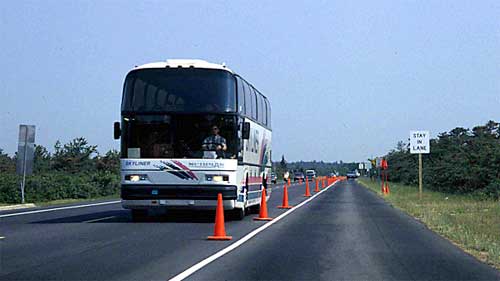
Managing Travel for Planned Special Events
Chapter Six.
Traffic Management Plan
Page 1 of 9

Figure 6-1. Temporary Reversible Lane Operation
Purpose 
This chapter details the components of the traffic management plan, which represents the main product of the event operations planning phase. A traffic management plan indicates how traffic, parking, and pedestrian operations will be managed on the day-of-event. The plan contains strategies and tactics for mitigating travel impacts identified in a planned special event feasibility study analysis (Chapter 5). It also accommodates travel demand management initiatives aimed at improving transportation system operations on the day-of-event.
This chapter provides data, guidelines, procedures, and checklists, supported by numerous example applications, to assist practitioners in developing a traffic management plan. A comprehensive plan consists of a site access and parking plan, pedestrian access plan, traffic flow plan, traffic control plan, en-route traveler information plan, traffic surveillance plan, and traffic incident management and safety plan. Sections on plan components and analysis and modeling further guide practitioners by presenting a fundamental background on traffic management plan development and evaluation. The organization of this chapter allows practitioners to conveniently extract information on developing a particular traffic management plan component. At the same time, this chapter guides the user in integrating the components into an overall plan.
Introduction 
After identifying traffic operations deficiencies in the planned special event feasibility study, the next step for the event planning team is to develop a traffic management plan that details traffic, parking, and pedestrian management techniques to mitigate any and all anticipated problems on the day-of-event. The challenge to stakeholders involves not only developing a strategy to mitigate a potential congestion or safety hot spot, but also ensuring each tactic does not defeat the objectives of another.
A breakdown (e.g., pedestrian flow) occurring at the venue, parking areas, site access roads, transit system, local street system, or regional corridors serving the event can yield a potential snowball effect on other integrated components of the transportation system. A proactive traffic management plan for planned special events prohibits individual transportation system components from impeding one another. It represents a flexible plan that can adapt to and optimize proposed transit service changes and travel demand management initiatives.
The scope of a traffic management plan varies for each planned special event, even for events happening in the same jurisdiction or region. Different strategies and tactics are successful in handling different categories of planned special events occurring in metropolitan, urban, and rural areas. A successful traffic management plan satisfies both the: (1) customer requirements of all transportation system users and (2) allotted budget for personnel and equipment resources assigned to the day-of-event operation. From a program planning perspective, the deployment of automated systems at a particular venue improves travel management for all future planned special events at the venue. Similarly, a portable system obtained for use during a particular planned special event may be used by practitioners to manage future planned special events in a region.
Planned Special Events Traffic Management | Privacy Policy